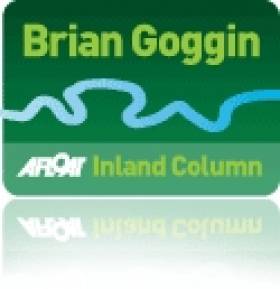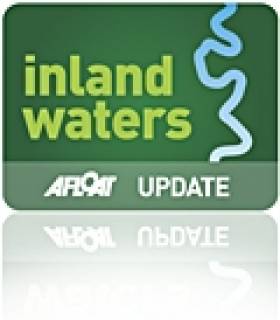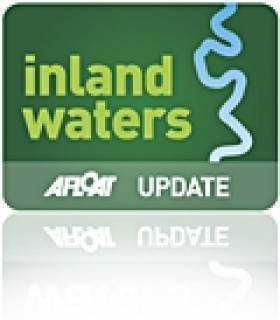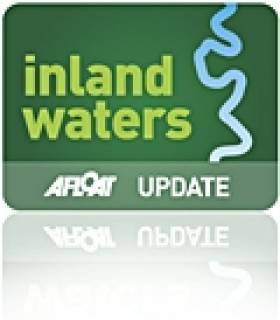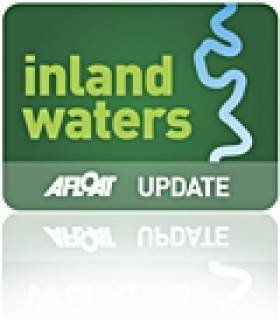Displaying items by tag: Royal Canal
Controlling The Canals
I wrote recently that the terms of Waterways Ireland's licence agreement for the "Extended Term Serviced Mooring Vacancies" at Shannon Harbour could be easily adapted for use elsewhere on the canals. That might allow WI to begin to bring the long-term berthers, residential or otherwise, under control. And so it proves. We have received this press release from Waterways Ireland.
WI Press Release
Waterways Ireland has recognised that many boat owners wish to stay for a more extended period in a single location than the 5 days the annual Canal Mooring and Passage Permit (under the Canals Act, 1986 (Bye-laws), 1988) currently allows.
In response, Waterways Ireland intends to issue an Extended Mooring Licence granting a boat owner the right to leave their boat in one location for longer than 5 days. This permit will enable the holder to moor in a position allocated by Waterways Ireland on a soft bank area of navigation property for a period of up to 1 year. The Extended Mooring Licence will cost e152 per annum.
The application process for the Extended Mooring Licence will open in the autumn when all existing permit holders will be contacted.
All boat owners will still require an annual Canal Mooring and Passage Permit allowing the holder to cruise and pass through locks. Boat owners with a Canal Mooring and Passage Permit proposing to stay longer in one location than 5 days can then apply for the Extended Mooring Licence. The total fee to hold both the Permit and the Licence in 2012/2013 will be e278.
For boat owners with the Canal Mooring and Passage Permit who do not hold an Extended Mooring Licence, the 5-day rule (in the one place or within 500m of that location) will still apply. Waterways Ireland will enforce this bye-law from autumn 2012.
Waterways Ireland will be contacting permit holders regularly between now and autumn 2012 to ensure they are kept up to date with the roll-out of the new permit. All queries about the enforcement of the current bye-laws or the Extended Mooring Licence should be directed to Shane Anderson, Assistant Inspector of Navigation: Tel no +353 (0)87 286 5726, Email [email protected].
These changes are necessary steps to improve the management of the canals and waterway amenities for both the navigational and recreational user, so that investment in the new infrastructure and facilities which Waterways Ireland has undertaken is maximised for every user.
Comment
About time too. I welcome this development: WI has to be able to control who uses its waterways and the uses they make of them.
The proposed charge is surprisingly modest. It is the same for all areas, those of high and of low demand: it might have been difficult to implement differential charging. However, the new licence does not apply to hard-edged areas; I presume therefore that WI intends to keep them clear for visitors.
It is significant that the new control mechanism is a licence, not a permit. Waterways Ireland had been hoping to bring in a single set of bye-laws to cover all its navigations, but it proved to be very difficult to do that within two jurisdictions. Accordingly, I understand that WI now intends to seek amendments to the bye-laws for the Republic, allowing it (inter alia) to increase the charges for various permits. However, the Canals Act 1986 allows WI to issue licences, and they are not subject to the restrictions in the bye-laws.
Royal water
The fragility of the water supply to the Royal Canal was shown in April, when Waterways Ireland closed the summit level of the canal because of low water levels; the 34th and 35th levels were also closed for emergency repairs. At time of writing, WI is hoping to be able to re-open the summit level on 1 June. Some boats that had intended to go west along the Royal to the Shannon were forced to go east instead, through Dublin and along the Grand Canal; happily, Effin Bridge, the lifting bridge at North Strand Road, worked properly this year.
The Royal always had fewer feeders than the Grand. The summit level was fed from Lough Owel, north of Mullingar, but while the canal was closed, Westmeath County Council found it needed more drinking water for the Mullingar area. In dry conditions, the Lough Owel feeder cannot meet both needs.
With great foresight, CIE (which then owned the canal) got the Council to agree that, if the canal was to be re-opened, it would provide an alternative supply.
Nowadays, environmental regulations mean that water abstraction needs more thought, more planning and more factors to be considered. Extensive studies were carried out and WI and the County Council agreed that the best possible alternative source was Lough Ennell, which is south of Mullingar: water could be pumped from there to the canal. The Council had to apply to An Bord Pleanála for permission; it has just completed oral hearings in Mullingar.
Traditional boats
In the first half of the nineteenth century, anyone travelling to the seaside resort of Kilkee could take the steamer to Kilrush and travel onward by road. But the passenger traffic was initially established by the turf boats of the Shannon Estuary: most of Limerick's fuel came from Poulnasherry, west of Kilrush, and was carried by small sailing boats, which also carried a few passengers.
A 24' replica of one of these boats was launched recently at Querrin, at the entrance to Poulnasherry. The Sally O'Keeffe was built by the Seol Sionna group http://seolsionna.org/, which grew out of the West Clare Currach Club. The boat will be used for sailing training. The Shannon Estuary, which is insufficiently appreciated, has a wealth of traditional boat types, but there were no extant Shannon hookers, so it is nice to see their return.
On the same weekend, another of those traditional boat types was featured in Limerick. The Ilen Wooden Boat Building School http://ilen.ie/gandelow-races/ had built five gandelows, boats used in the upper reaches of the estuary, and conducted races in the city.
And the Thomastown Regatta, on the Nore http://www.happyvalleyfestival.com/ebooklet.pdf, will feature traditional cots and racing boats: the 1905 racing cot Nore Lass, owned by the O'Farrell family, will be on display at the Grennan Mill Craft School.
Here are some updates I wrote about recently...
Water charges
The EU Commission sent a Reasoned Opinion to Ireland in November 2011, suggesting that Ireland had not correctly implemented the provisions of the Water Framework Directive that require "a cost recovery policy for water services that includes the environmental and resource costs of water use". The Commission believes that cost recovery should be extended to many other water uses, including hydroelectricity generation and the supply of water to navigations. Having got an extension of the deadline for replying, the Department of the Environment, Community and Local Government responded to the Commission. I asked for a copy of the response, but the department won't tell anybody what it's doing. I am appealing that decision, but without much hope.
Traffic
Waterways Ireland has kindly given me the Shannon traffic figures for the first four months of 2012. The numbers of movements in those months are always low, and can be significantly affected by the weather, so there can be quite a lot of variation between one year and another without its indicating any long-term trend. For example, back in 2002, there were 4875 boat movements in the first four months; the figure was up to 6204 in 2003 but back down to 5304 in 2004. It's important therefore not to read too much into the figures, but a five-year moving average suggests that traffic has been falling since 2007. The figure for 2012 was 4052. It will be interesting to see whether better weather balances economic gloom in the rest of the year.
Mineral Oil Tax
In the last issue, I gave the figures for the numbers of Mineral Oil Tax returns received by Revenue from owners of diesel-powered boats in the first two years of the scheme's operation. They told me that they got 38 returns in 2010 for the year 2009 and 41 in 2011 for 2010. I now have the figure for the following year, the returns made in 2012 for the year 2011. There was a very significant change, of 46%, but unfortunately it was downward, to 22. The Revenue Commissioners tell me that "[...] there were 22 returns received by 1 March 2012 for 2011, amounting to e53,398.58 MOT [Mineral Oil Tax] on 141,503.29 litres oil." That's an average of 6432.1 litres each, which is a lot, so I suspect that much of the total came from the hire fleet, with less than twenty private owners making returns.
Royal and Ulster Canals
I said, in the last issue, that I did not understand how the cost of the restoration of the Royal Canal, 146 km with 46 locks, could be less than the expected cost of the canal to Clones, 13 km with one double lock. It has been explained to me that the figure for the Royal was essentially only the marginal cost, recorded (initially) under Civil Service accounting procedures, so that it understates the total cost. It would be a huge job to try to find the full cost using modern accounting conventions, but unfortunately that means that we have no usable figure for the cost of the Royal, no basis for estimating the return on investment and no guideline on the value of any future restorations.
Grand, Royal Canal & Barrow Navigation Mooring Rules Come into Force
#inland – Waterways Ireland announced in June 2012 that the Canal Bye-laws on the Grand & Royal Canal and Barrow Navigation are to be enforced from autumn 2012, with an accompanying change in the permit system allowing for year-long mooring permits and locations.
Part of bringing in this new location-based permit has been the identification of locations suitable for extended mooring. This process is now completed and work has begun in some areas to improve accessibility.
Waterways Ireland will roll out Extended Mooring Permit applications by area, rather than giving a date when applications for the permit will open. For boat owners this will mean that enforcement of the maximum stay rule will not commence in an area until after boat owners have had the opportunity to purchase an Extended Mooring Permit.
The initial 12 month Extended Mooring Permit will cost €152 and will only be available to boats already holding a valid annual Mooring and Passage Permit.
Boats that cruise and move (staying at a mooring for up to 5 days) will not be in breach of the Bye-laws or require an Extended Mooring Permit.
Waterways Ireland has proposed a small number of draft amendments to the current Bye-laws which date from 1988. These include proposals to provide a range of charges for mooring permits that reflect the location and services provided throughout the canals and also will take into account the size of boat. These proposals include low cost rural moorings on soft banks to ensure the canals are accessible for everyone who owns a boat and requires a mooring. Boat owners allocated an extended mooring location in key areas in villages or towns or with services should be aware that if the new Bye-laws are approved Waterways Ireland will increase the charges for moorings in the future to reflect the location, services, and size of boat.
Waterways Ireland recognises the current situation whereby a small number of boat owners use their boats as their sole or permanent residence. Proposals to make provision for this use of the navigation property have been included in the Bye-law changes.
Furthermore Waterways Ireland intends to work towards the provision of a small number of serviced house boat moorings on the canal network. Such provision will be subject to finance, land availability and compliance with requisite statutory approvals.
Waterways Ireland recognises that a transition period of a number of years will be required to implement this. In the interim these boat owners should apply for an Extended Mooring Permit.
The draft Bye Law amendments are currently being considered by Waterways Ireland's sponsor Departments. When Waterways Ireland has Ministerial consent, it will proceed to public consultation on the proposed Bye-law amendments.
Waterways Ireland will continue to contact permit holders regularly to ensure they are kept up to date with the roll-out of the new permit. All queries about the enforcement of the current bye-laws or the Extended Mooring Permit should be directed to Shane Anderson, Assistant Inspector of Navigation: Tel no +353 (0)87 286 5726, Email [email protected] . Queries about houseboats should be directed to Property & Legal Section Tel no +44 (0)28 6632 3004.
These changes are necessary steps to improve the management of the canals and waterway amenities for both the navigational and recreational user, so that investment in the new infrastructure and facilities which Waterways Ireland has undertaken is maximised for every user.
Minister Proposes Dublin-to-Galway Cycle Path Via Royal Canal
#ROYAL CANAL - The Royal Canal towpath is an "obvious candidate" for a stretch of the new cross-country cycle route from Dublin to Galway proposed by the Minister or Transport.
The Irish Times reports that Minister Leo Varadkar has instructed the National Transport Authority (NTA) to examine possible routes for the project, which would involve development of the present towpath along the waterway from Mullingar to Maynooth.
The NTA is already funding preparatory work with a view to upgrading the canal path as a premium quality Greenway Route for cyclists and pedestrians in the Fingal area from Ashtown to Westmanstown - and will now look at the feasibility of extending this project through Leixlip to Maynooth.
“A national off-road cycle trail would be a first for Ireland and would be a great tourism asset," said the minister, who added that the scheme has "the potential to bring in at least €15 million per annum, much of that going straight into local businesses along the route.”
Waterways Notice: Royal Canal Closure in Meath, Lower Bann Lock Restrictions
#INLAND WATERWAYS - Waterways Ireland has issued notice of a planned closure of the Royal Canal in Clonard, Co Meath over the winter months, as well as restrictions on the Lower Bann this coming Wednesday.
In Clonard, the stretch of the canal between Blackshade Bridge and Hill of Down will be closed from 1 October 2012 till 17 March 2013 to facilitate essential bank strengthening works.
Waterways Ireland wishes to thank all owners and masters of vessels using the Royal Canal for their co-operation in this matter.
Meanwhile, on the Lower Bann there will be an interruption to electricity supply in the Movanagher area in Co Derry this Wednesday 19 September.
All owners and masters are advised that there will be restricted access to Movanagher Lock and swing bridge on that date, and vessels of more than 26 feet (8 metres) will not be permitted to make passage.
Strange Goings On As Turtle, Carp Appear in Royal Canal
#INLAND WATERWAYS - The Irish Times recently reported on some strange and unusual findings along one of Ireland's longest inland waterways this summer.
Angler Tony Masterson was more than a little surprised to discover he had caught a red-eared slider turtle in the Mullingar section of the Royal Canal last month.
The 30cm turtle is of a species native to the southern United States, so is presumably an abandoned pet - a cause of concern as the number of invasive species in Ireland continues to expand.
Inland Fisheries Ireland (IFI) senior scientist Joe Caffrey reminded the public that it is "illegal to release any species that is not normally resident in Ireland into the wild" and added that the IFI "will continue to monitor the canal to ensure this is a once-off case".
Curiously, a wild salmon was caught the same stretch of canal last year.
It's thought that the salmon entered the canal via the water supply system from Lough Owel, which is connected to the Shannon by the River Inny.
IFI officers have also confirmed the sighting of a koi carp in the Royal Canal, which "appears to be in good condition".
Public Consultation on Royal Canal Greenway Study
#INLAND WATERWAYS - Fingal County Council invites any interested parties to make submissions on the future of the Royal Canal as a Greenway Route in the Fingal area.
The council, in conjunction with the National Transport Authority and Waterways Ireland, has identified the potential to upgrade the canal towpath along the Royal Canal from Ashtown to Westmanstown to a premium quality cycle and pedestrian route.
The feasibility of the Royal Canal for such facilities and as an improved recreational amenity is currently being examined. Among the issues being considered are:
- Feasibility of providing a high quality continuous footpath/cycleway along the towpath
- Potential to provide parallel routes where towpath route not feasible
- Improvements to accessibility issues at interfaces with public roads
- Improved amenity areas (car parking, picnic areas, angling, boating)
- Environmental and heritage issues
- Improved connectivity with local residential areas and adjacent rail and bus services
- Integration with adjacent cycle routes (existing and proposed)
Submissions or observations may be made in writing to Senior Executive Officer, Planning & Strategic Infrastructure Department, Fingal County Council, Main Street, Swords, Co Dublin to arrive no later than 5pm on 25 May 2012 or e-mail to [email protected].
Father-Son Duo in Charity Paddle from Dublin to Donegal
#KAYAKING - A father-and-son duo from north Co Dublin will shortly embark on an epic kayak paddle from Dublin to Donegal, the Fingal Independent reports.
Dermot Higgins and his son Fionn, from Rush, will attempt to kayak from Dublin Port to the Atlantic Ocean at Ballyshannon - a distance of some 330km - by way of the Royal Canal, the River Shannon and Lough Erne.
The Higgins' - who believe they are the first to attempt such a feat - will be completely self-sufficuent for the duration of the challenge, which is hoped to raised funds for the Rush Open Organisation for Transition Status (ROOTS), a charity that intends to help communities reduce their carbon footprint and face up to environmental challenges by encouraging sustainability.
The Fingal Independent has more on the story HERE.
Royal Canal Site In Phibsborough On the Market
#WATERFRONT PROPERTY - A prime development opportunity on the banks of the Royal Canal in Phibsborough is now available.
With an asking price of €1.5 million, the site of the Old Mill Bakery is situated just 1.5km from Dublin city centre and is adjacent to the amenities of Phibsborough Shopping Centre, with 150 metres of frontage on the Royal Canal.
Zoned Z1 for residential, the 1.6 acre site has great potential for residential or mixed use development. A feasibility study is available for any housing schemes.
Viewing is strictly by appointment only. For more details visit the website of estate agent CB Richard Ellis HERE.
It is only in recent years that larger vessels can berth at this stretch of the waterfront following the completion of several major construction projects over the last decade. From the building of the Convention Centre and the Samuel Beckett Bridge which involved using the dredger Hebble Sand (click HERE) during its construction process.
In addition the refurbishment of Spencer Dock sea-lock entrance that for many years was closed is now re-opened. The dock entrance featured in the start of the new television series 'Waterways'-The Royal Canal. Episode two is this Sunday on RTE 1 at 8.30pm.
Aside the 79m L.E. Roisin, the last large vessel to berth close to berth 16A was the French 58m tallship Belem, which was chartered by Alliance Francaise to celebrate their 50th anniversary in 2010 and for the inaugural French Hoist the Sail: Market Festival. The three-masted barque built in 1896 was once also owned by the Sir Arthur Ernest Guinness under the name of Fantôme II.
Situated between where L.E. Roisin is currently berthed and where the Belem had moored, is home to the 'resident' M.V. Cill Airne, a floating bar and restaurant dining venue at berth 16B. Another resident is the former lightship Kittiwake at berth 17B, though sited much further downstream at the end of North Wall Quay, opposite the O2 Arena and next to the East-Link Bridge.
There is a fourth resident, again berthed on the north quays, though the Jeanie Johnston unlike her counterparts is moored closer to the city-centre at Custom House Quay. Apart from yachts, leisure-craft and occasional private motor-yachts using the Dublin City Moorings, she is the only vessel to permanently occupy a berth between Samuel Beckett Bridge and the Sean O'Casey foot-bridge.
- inland waterways
- Dublin Port
- Dublin Docklands
- Royal Canal
- Jeanie Johnston
- naval service
- Custom House Quay
- Alliance Française
- Spencer Dock
- Sean O'Casey Bridge
- River Liffey
- Belem
- Sir John Rogersons Quay
- TallShips
- North Wall Quay
- Fantome II
- Dick Warner
- Dublin City Moorings
- Navy News
- O2 Arena
- EastLink bridge
- LE Roisin
- Sir Arthur Guinness
- National Convention Centre Dublin
- Samual Beckett Bridge
Waterways Returns to the Screen This Sunday
Waterways returns to RTÉ television after 16 years off the air this coming Sunday.
The original award-winning 1990s documentary series saw naturalist and poet Dick Warner undertake an epic journey traversing the canals of Ireland by barge.
This year filmmaker Stephen Rooke accompanied Warner as he returned to our inland waterways, this time to explore the newly restored Royal Canal and celebrate the reopening of the entire route from Dublin to the Shannon.
As previously reported on Afloat.ie, Warner travels on the Rambler, an original canal tug barge, from Dublin to Lough Ree - the first time it had followed the route since 1923.
Along the way, Warner meets both experts and ordinary people who live along the banks, learning from them about its heritage, history and wildlife.
Filming is now complete on the new six-part series, Waterways - A Royal Canal, which begins this Sunday night.
According to Irish Film and Television News, Rooke re-assembled the core team from the original series, many of whom have gone on to work on successful films and TV shows.
The series begins on RTÉ One at 8.30pm on Sunday 2 October.




























